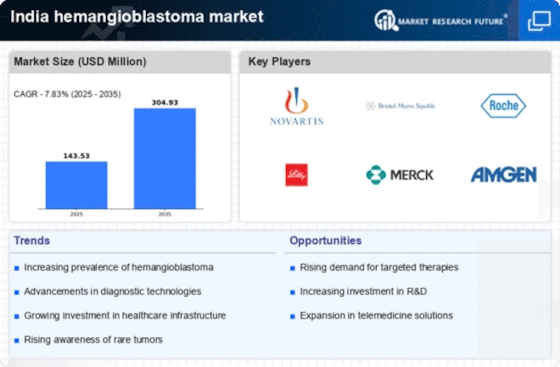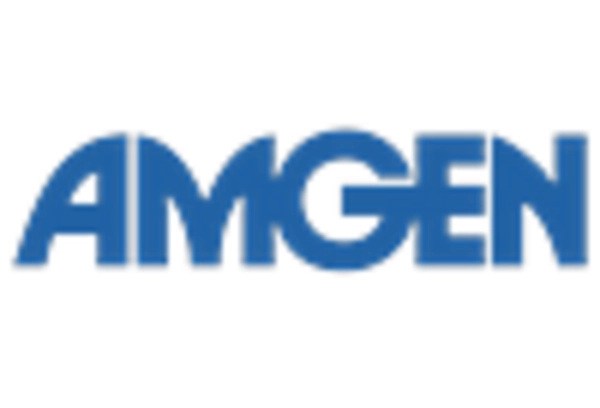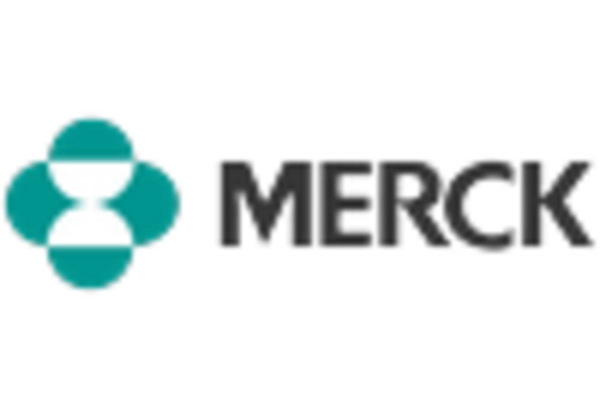Advancements in Surgical Techniques
Innovations in surgical techniques are significantly impacting the hemangioblastoma market in India. The introduction of minimally invasive procedures, such as endoscopic and robotic surgeries, has improved patient outcomes and reduced recovery times. These advancements not only enhance the efficacy of tumor removal but also minimize complications associated with traditional surgical methods. As a result, more patients are likely to opt for surgical interventions, thereby driving demand within the market. Additionally, the integration of advanced imaging technologies, such as MRI and CT scans, aids in precise tumor localization, further supporting the growth of the hemangioblastoma market. The ongoing development of surgical tools and techniques is expected to continue influencing treatment paradigms, potentially leading to increased market penetration and revenue generation.
Rising Incidence of Hemangioblastoma
The increasing incidence of hemangioblastoma in India is a crucial driver for the hemangioblastoma market. Recent studies indicate that the prevalence of this rare tumor type is on the rise, with estimates suggesting that it affects approximately 1 in 100,000 individuals annually. This growing patient population necessitates enhanced diagnostic and therapeutic options, thereby stimulating market growth. As healthcare providers become more aware of the condition, the demand for specialized treatments and interventions is likely to increase. Furthermore, the rising incidence may lead to more research funding and clinical trials, which could further propel the hemangioblastoma market in India. The need for effective management strategies for hemangioblastoma is becoming increasingly apparent, indicating a potential for significant market expansion in the coming years.
Rising Patient Advocacy and Support Groups
The emergence of patient advocacy and support groups is playing a vital role in shaping the hemangioblastoma market in India. These organizations are dedicated to raising awareness about hemangioblastoma, providing resources for patients and families, and advocating for better treatment options. Their efforts contribute to increased public knowledge and understanding of the condition, which may lead to earlier diagnosis and intervention. Furthermore, these groups often collaborate with healthcare professionals and researchers to promote clinical trials and innovative therapies. As patient advocacy continues to grow, it is likely to influence policy changes and funding allocations, thereby enhancing the overall landscape of the hemangioblastoma market. The active involvement of these groups may also foster a supportive community, encouraging more individuals to seek treatment and participate in research initiatives.
Increased Focus on Research and Development
The heightened focus on research and development (R&D) in the field of oncology is a significant driver for the hemangioblastoma market. In India, various institutions and pharmaceutical companies are investing in R&D to discover novel therapies and treatment modalities for rare tumors. This trend is supported by government initiatives aimed at promoting innovation in healthcare. For instance, funding for cancer research has seen a substantial increase, with allocations reaching approximately $1 billion in recent years. Such investments are likely to lead to breakthroughs in the understanding and treatment of hemangioblastoma, thereby expanding the market. The collaboration between academia and industry is also expected to yield promising results, potentially enhancing the therapeutic landscape for patients and driving market growth.
Growing Investment in Healthcare Infrastructure
The expansion of healthcare infrastructure in India is a pivotal driver for the hemangioblastoma market. With the government and private sectors investing heavily in healthcare facilities, access to specialized treatment for rare conditions like hemangioblastoma is improving. Reports indicate that healthcare expenditure in India is projected to reach $370 billion by 2025, which could enhance the availability of advanced diagnostic and therapeutic options. This investment is likely to facilitate the establishment of specialized centers for the treatment of hemangioblastoma, thereby increasing patient access to care. Furthermore, improved infrastructure may attract international collaborations and research initiatives, fostering innovation within the hemangioblastoma market. As healthcare facilities expand, the potential for market growth becomes more pronounced, indicating a favorable environment for stakeholders.

















Leave a Comment